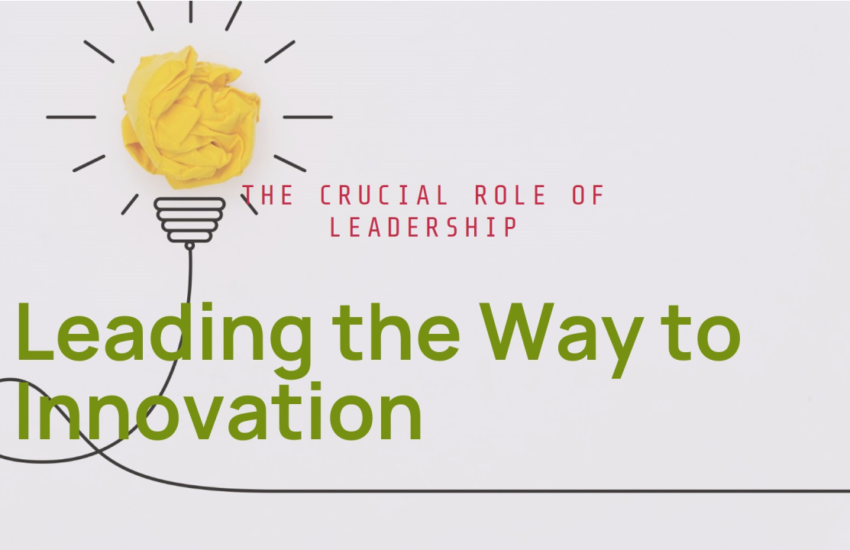Innovation is no longer optional; it is a critical driver of growth, adaptability, and competitive advantage. According to a report from McKinsey, companies that prioritize innovation see a 30% higher growth rate and a 15% increase in profit margins compared to their competitors. For organizations to thrive, it is essential to cultivate a culture where creativity and experimentation are encouraged, supported by leadership at every level. As the workplace continues to transform with new technologies and shifting models, leaders must adapt to foster an environment where innovation can flourish across all aspects of the organization.
The Role of Leadership in Fostering Innovation
Leaders are central to creating and sustaining a culture of innovation. According to a survey by PwC, 84% of executives say that innovation is crucial to their growth strategy. However, the same survey revealed that 47% of organizations lack the internal capabilities to execute their innovation strategies effectively. This gap underscores the need for leaders to not only advocate for innovation but to also create the conditions that allow it to thrive. Leaders must provide the necessary resources, such as time, funding, and training, and cultivate an environment that values experimentation and learning from failure.
Promoting Open Communication and Cross-Functional Collaboration
Effective innovation thrives in environments where open communication is encouraged, and cross-functional collaboration is the norm. A study by the Harvard Business Review shows that teams who engage in cross-functional collaboration are 20% more likely to innovate successfully. By breaking down silos and fostering communication between departments—whether it’s marketing working with product development or IT collaborating with customer service—organizations can leverage diverse perspectives and expertise. Leaders must encourage transparency and create platforms where employees feel comfortable sharing new ideas, which in turn leads to greater innovation.
Embracing New Technologies like Generative AI
The rapid advancement of technologies like generative AI is reshaping how businesses operate and innovate. According to a report by Accenture, AI has the potential to increase global GDP by $15.7 trillion by 2030, with much of this growth driven by AI’s ability to foster innovation in product development, customer experience, and operational efficiency. For example, companies like OpenAI and Google have already integrated generative AI into their workflows, enabling employees to rapidly prototype new ideas and test creative solutions. Leaders who embrace AI and other emerging technologies not only position their organizations for future growth but also set the stage for innovation across all levels of the workforce.

Encouraging Continuous Learning and Development
Innovation is an ongoing process, and for it to be sustained, employees must have access to continuous learning opportunities. A report by LinkedIn Learning shows that 94% of employees say they would stay longer at a company that invests in their professional development. By promoting a culture of continuous learning, organizations ensure that employees remain engaged and equipped to tackle new challenges. This can include formal training programs, access to online courses, mentorship opportunities, and support for attending industry conferences. Encouraging employees to expand their skill sets not only enhances their individual growth but also empowers them to contribute to the organization’s innovation efforts.
Recognizing and Rewarding Innovation
Recognizing and rewarding innovative efforts is a key component of sustaining a culture of innovation. A survey by Gallup found that employees who feel their contributions are recognized are 4.6 times more likely to be highly engaged. Leaders can foster innovation by celebrating both big and small wins, whether through public acknowledgment, monetary rewards, or professional development opportunities. For example, companies like Adobe and Zappos have created recognition programs that reward employees for their creative ideas and innovative contributions, fostering a sense of ownership and motivating others to think outside the box.

Fostering Employee Well-Being to Drive Creativity
Employee well-being is intrinsically linked to creativity and innovation. A report by Deloitte found that organizations with strong employee well-being programs experience 11% higher revenue per employee and 27% lower turnover rates. Mental and physical health directly impact an employee’s ability to think creatively and engage in innovative activities. Companies like Salesforce and Microsoft have long understood the importance of well-being, offering comprehensive health benefits, flexible work arrangements, and wellness programs to ensure their employees are in the best possible position to contribute creatively. By fostering a holistic approach to employee well-being, leaders create an environment that supports sustained innovation.
Adapting to New Work Models
The traditional workplace model is evolving rapidly. The shift towards remote and hybrid work models, accelerated by the COVID-19 pandemic, has changed the dynamics of innovation. A survey by McKinsey found that 84% of executives believe hybrid or remote work will continue in the post-pandemic era. As work becomes more decentralized, innovation must adapt. Leaders can embrace flexible work models that support innovation by leveraging digital tools for collaboration, ensuring that innovation is not limited by geographic or departmental boundaries. Tools such as Zoom, Slack, and Microsoft Teams allow employees to connect, share ideas, and collaborate across time zones, ensuring that innovation continues even in remote environments.
Building a Resilient, Innovative Organization
Cultivating a culture of innovation is essential for organizational growth and long-term success. By providing leadership that fosters creativity, encouraging continuous learning, embracing emerging technologies, and recognizing contributions, leaders can ensure that their organizations remain agile and competitive in an ever-changing business landscape. In addition, prioritizing employee well-being and adapting to new work models will sustain innovation and increase overall productivity. As technological advancements continue to reshape the workplace, leaders who prioritize innovation will be better positioned to drive their organizations forward, remaining resilient and adaptable in a rapidly evolving global market.








